15 Steep Hill Landscaping Ideas to Transform Your Sloped Yard
Transforming a sloped yard into a stunning outdoor retreat can be a rewarding challenge, and with the right design, even the steepest terrain can become a standout feature.
We will explore 15 steep hill landscaping ideas that combine functionality with eye-catching appeal. From terraced gardens and natural stone steps to cascading water features and erosion-control plantings, these creative solutions will help you make the most of your hillside space.
Whether you’re looking to enhance curb appeal or create a peaceful backyard oasis, these ideas will inspire your next landscape project.
1. Terraced Garden Beds
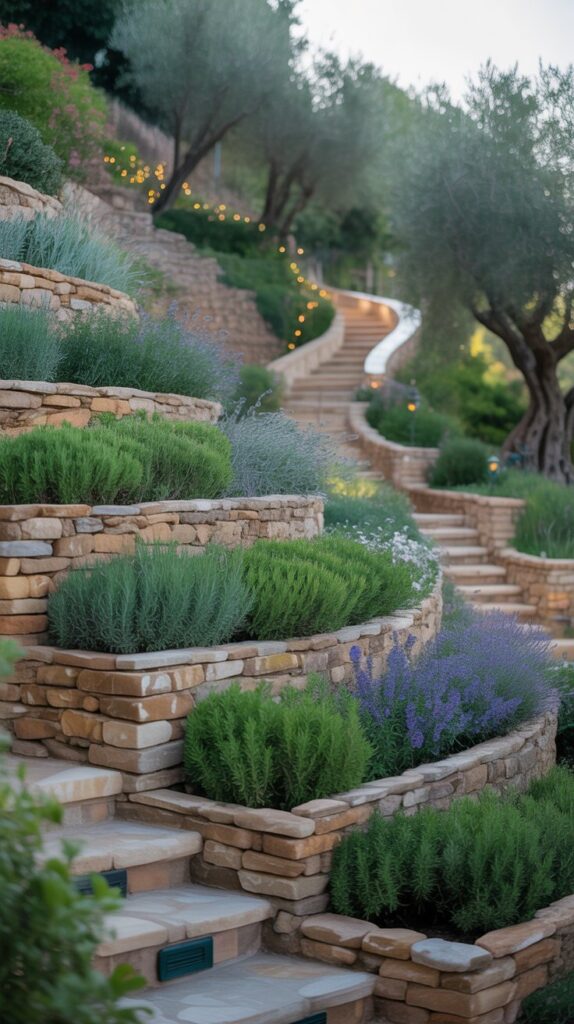
Terraced garden beds break up a steep slope into manageable, flat sections. This method prevents soil erosion and makes planting easier. You can use materials like retaining walls, stone, or timber to create the tiers, giving your hill a structured yet natural look.
For a cohesive design, plant each terrace with a mix of perennials, shrubs, and ground covers. Consider adding edible plants like herbs or strawberries for a functional touch.
2. Retaining Walls with Built-In Seating
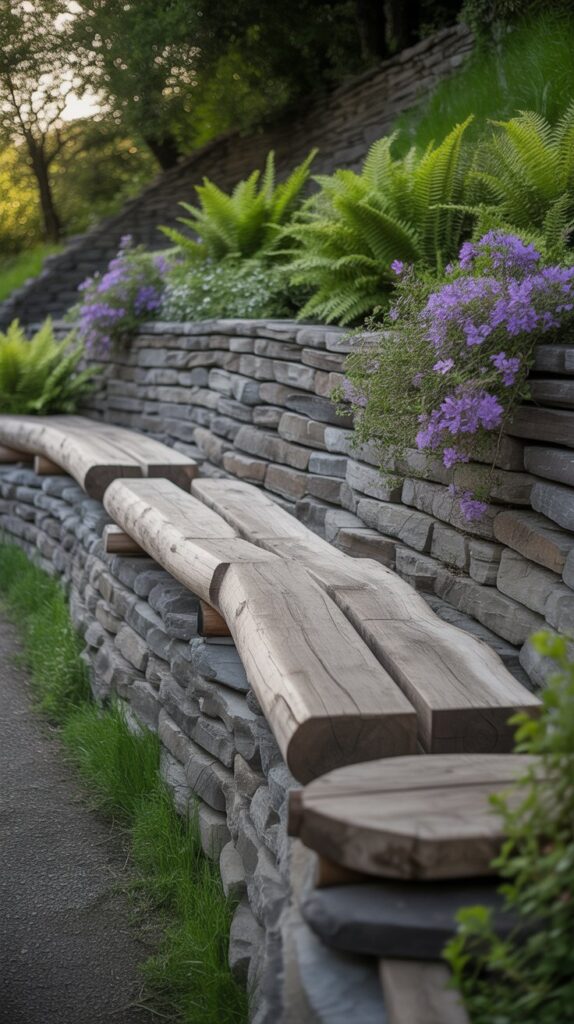
A retaining wall does more than hold back soil—it can double as seating. Use sturdy materials like concrete blocks or natural stone to build a wall with a wide, flat top. This creates a casual spot to sit and enjoy the view of your landscaped slope.
Incorporate weather-resistant cushions or wooden benches for comfort. You can even plant trailing flowers like ivy or creeping thyme along the edges to soften the hardscape.
3. Rock Gardens for Low Maintenance
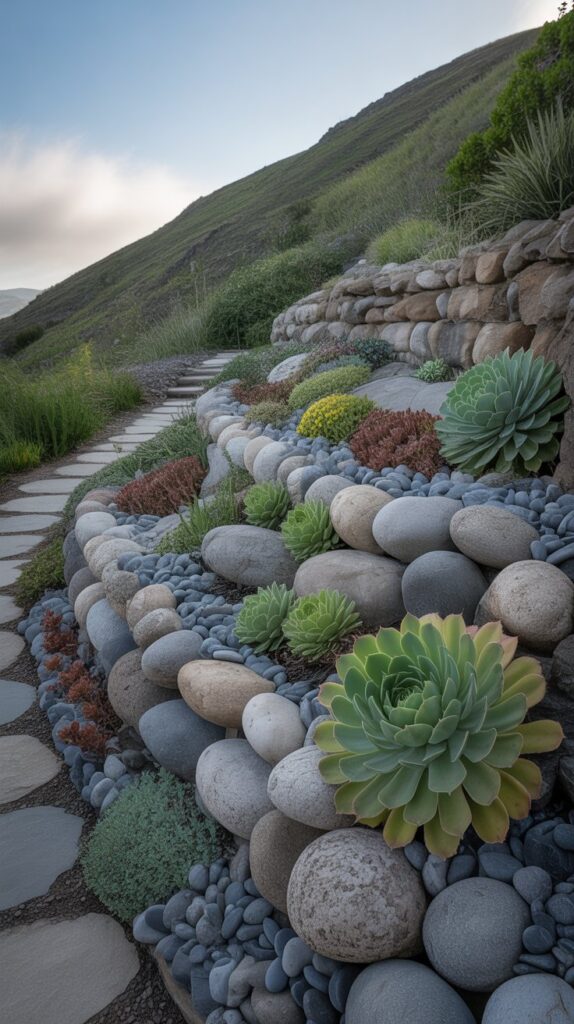
Rock gardens are perfect for steep hills because they require little upkeep and help with drainage. Arrange large boulders and smaller rocks in clusters, leaving pockets of soil for drought-resistant plants like sedum, lavender, or ornamental grasses.
The rocks add texture and prevent soil from washing away during heavy rain. For a natural look, mimic how rocks would naturally settle on a slope. Add a few succulents or alpine plants for pops of color that thrive in rocky conditions.
4. Ground Cover Plants to Prevent Erosion
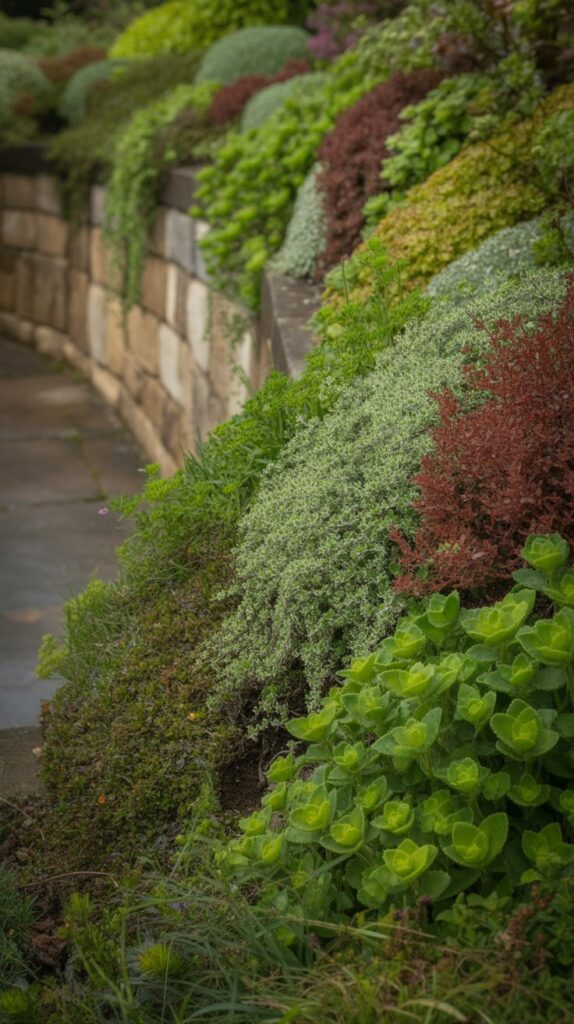
Ground cover plants are a simple solution for stabilizing a slope. Choose varieties like creeping juniper, vinca, or pachysandra that spread quickly and form dense mats. These plants hold soil in place and reduce the need for mulch or other erosion controls.
For a more colorful option, try thyme or ice plant, which bloom in vibrant shades. Ground covers also cut down on weeding since they crowd out unwanted growth. Just be sure to pick plants suited to your climate and sunlight conditions.
5. Cascading Water Feature

A cascading water feature turns a steep hill into a soothing focal point. Use natural stone or preformed basins to create a series of small waterfalls that flow down the slope.
Pair the water feature with moisture-loving plants like ferns or hostas for a lush look. If you’re handy, you can build a DIY version with a recirculating pump. For a low-maintenance option, opt for a dry creek bed that mimics a stream during rainstorms.
6. Staircase with Planting Pockets
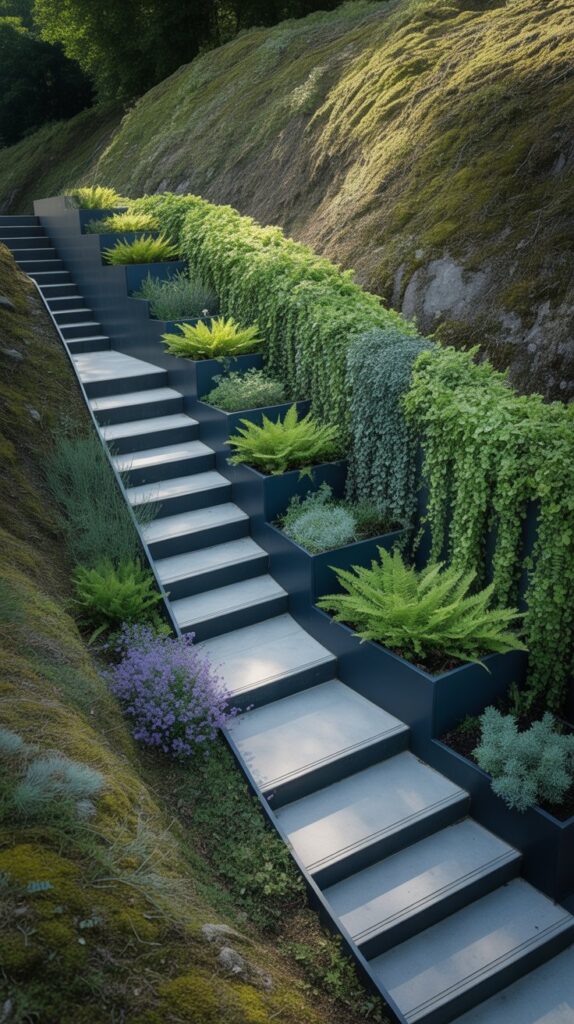
A staircase makes navigating a steep hill safer and more inviting. Instead of a plain set of steps, build them with planting pockets on either side. Fill these pockets with trailing plants like ajuga or sweet potato vine for a soft, organic feel.
Use materials that blend with the landscape, such as flagstone or railroad ties. For extra stability, anchor the steps with gravel or compacted soil. This idea combines practicality with beauty, making the hill a functional part of your yard.
7. Switchback Pathways

A switchback pathway winds back and forth across a slope, making the climb easier. This design reduces the steepness of the ascent and creates a more gradual incline. Use gravel, pavers, or stepping stones to define the path and improve traction.
Line the pathway with low-growing plants or solar lights for visibility at night. Switchbacks also add a sense of discovery, as each turn reveals a new section of the garden. This works well in larger yards where you want to encourage exploration.
8. Native Plantings for Wildlife
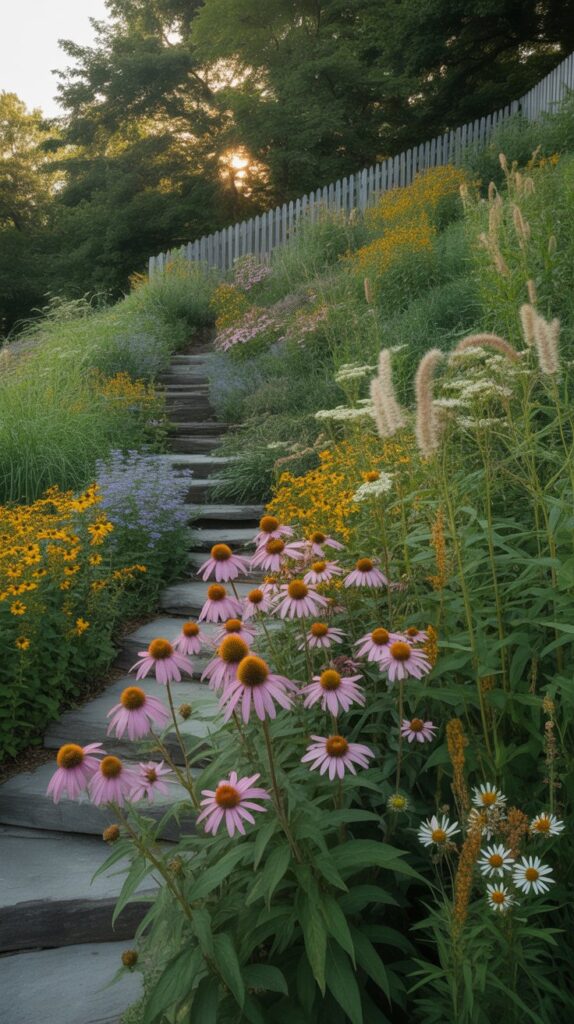
Native plants are ideal for steep hills because they’re adapted to local conditions. Choose species that thrive in your area, like black-eyed Susans or switchgrass, to create a habitat for birds and pollinators.
Group plants in drifts for a naturalized look that mimics wild landscapes. Add a birdbath or small pond to attract even more wildlife. This approach not only stabilizes the slope but also supports local ecosystems.
9. Gabion Walls for Modern Appeal

Gabion walls are wire cages filled with rocks, offering a modern twist on traditional retaining walls. They’re sturdy, permeable, and blend well with natural surroundings. Use them to terrace a slope or create raised planting beds.
The rocks inside can match your landscape—try river stones for a smooth look or jagged granite for contrast. Gabions also work well with succulents or grasses planted in the gaps.
10. Drought-Tolerant Succulent Slope
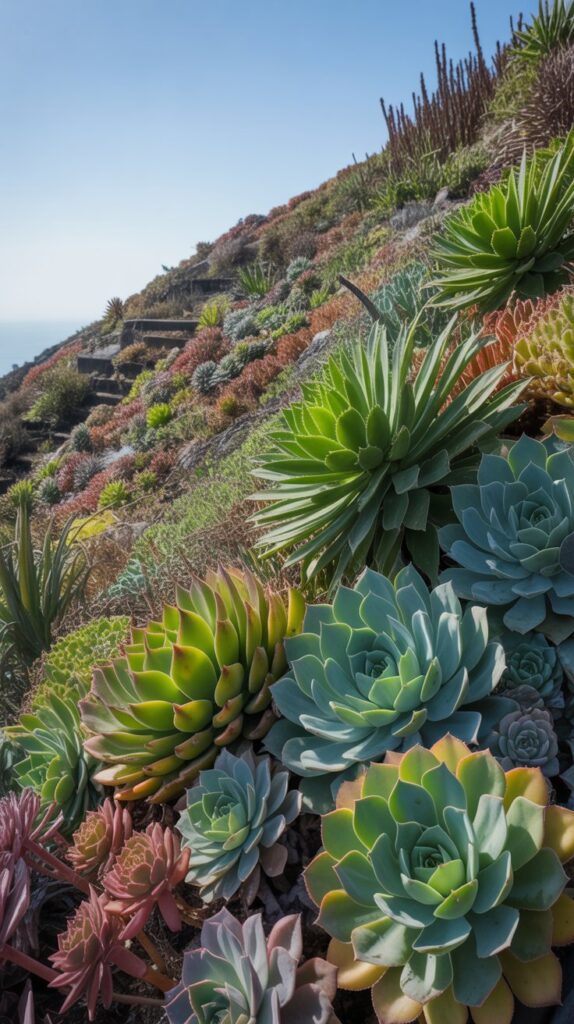
A succulent slope is both striking and water-wise. Plants like agave, aloe, and echeveria thrive in poor soil and need minimal irrigation. Their bold shapes and colors create a sculptural effect on a hillside.
Arrange succulents in clusters, leaving space for them to spread. Add decorative gravel or sand between plants to enhance the desert vibe. This idea is perfect for hot, dry climates where other plants struggle.
11. Wildflower Meadow for Seasonal Color
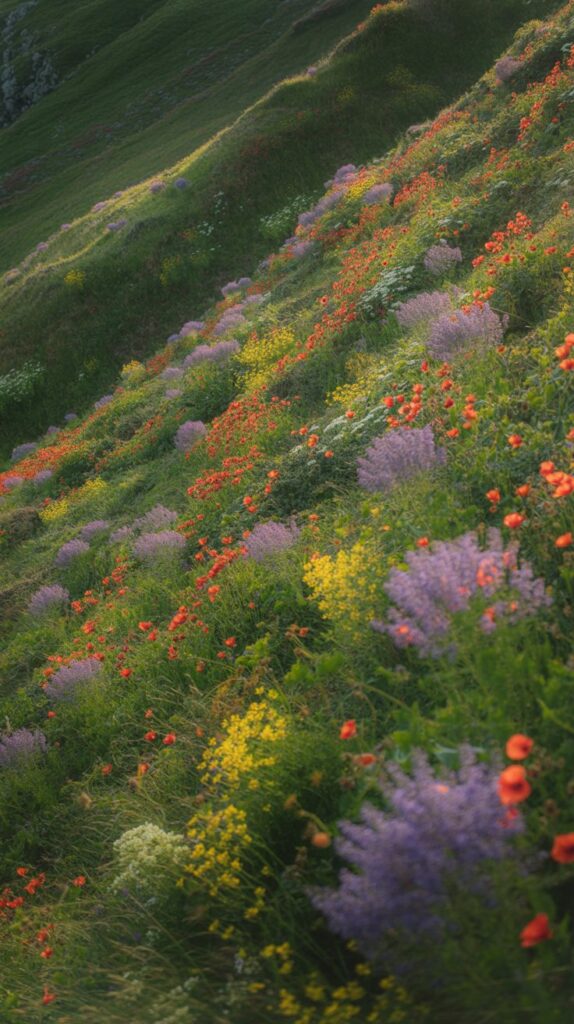
A wildflower meadow brings bursts of color to a steep hill throughout the year. Scatter a mix of native wildflower seeds in spring or fall, and let nature do the rest. The deep roots of wildflowers help prevent erosion while attracting butterflies and bees.
Choose a blend that blooms at different times for continuous interest. Avoid mowing to let the plants self-seed. This low-effort option is ideal for large slopes where maintenance is a concern.
12. Fruit Tree Orchard with Terraces

Turn your slope into a fruit tree orchard with terraced planting areas. Dwarf varieties of apple, cherry, or peach trees work well on hills. The terraces ensure proper drainage and make harvesting easier.
Underplant with strawberries or herbs to maximize space. This idea combines beauty and productivity, giving you a edible landscape that’s also visually appealing. Just be sure to stake young trees until their roots establish.
13. Woodland Garden with Ferns and Moss

A woodland garden suits shady, steep slopes. Plant ferns, hostas, and mosses for a lush, green carpet that thrives in low light. Add native shade trees like dogwood or redbud for height and structure.
Use natural mulch like leaf litter to mimic forest floors and retain moisture. This idea creates a serene, low-maintenance retreat that feels like a hidden grove.
14. Gravel and Stone Mulch for Minimalism
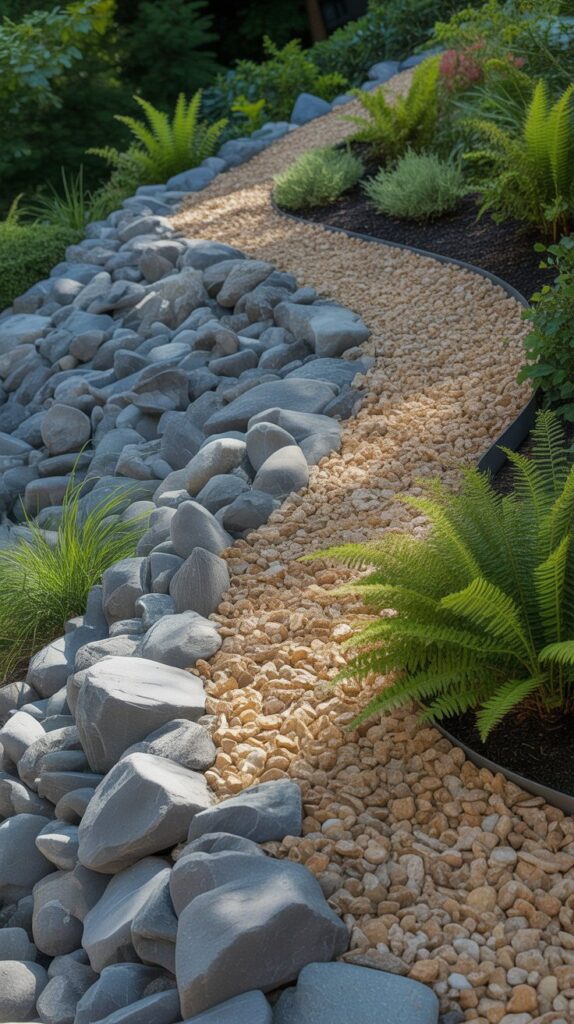
Gravel and stone mulch are practical for steep slopes where organic mulch washes away. Spread a thick layer of crushed granite or river rock to suppress weeds and improve drainage. Pair with drought-tolerant plants for a clean, minimalist look.
This approach works well in modern or xeriscaped gardens. For contrast, mix different stone sizes or colors to create patterns. It’s a no-fuss solution that still looks intentional.
15. Vertical Garden on Retaining Walls
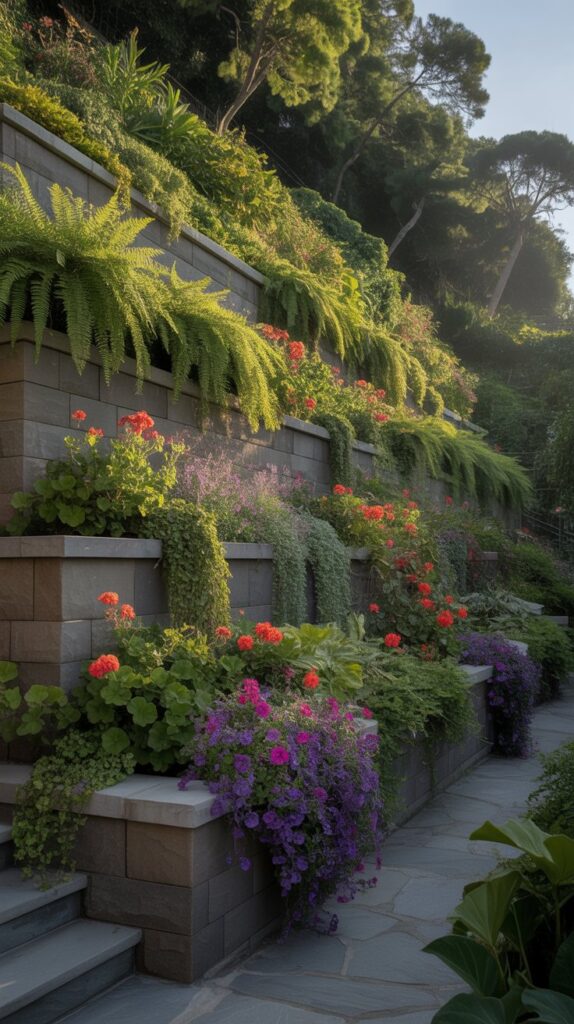
Turn a retaining wall into a vertical garden with pockets or trellises. Plant climbing vines like clematis or jasmine to cover the wall in greenery. Add hanging planters with trailing flowers for extra dimension.
This idea maximizes space and softens hard surfaces. It’s especially useful in small yards where every inch counts.
- 20 Stylish Gray Living Room Ideas for a Modern Cozy Look - July 3, 2025
- 15 Easy Home Garden Ideas You Can DIY Today - July 2, 2025
- 15 Cozy Cottage Core Kitchen Ideas for Whimsical Charm - June 30, 2025







